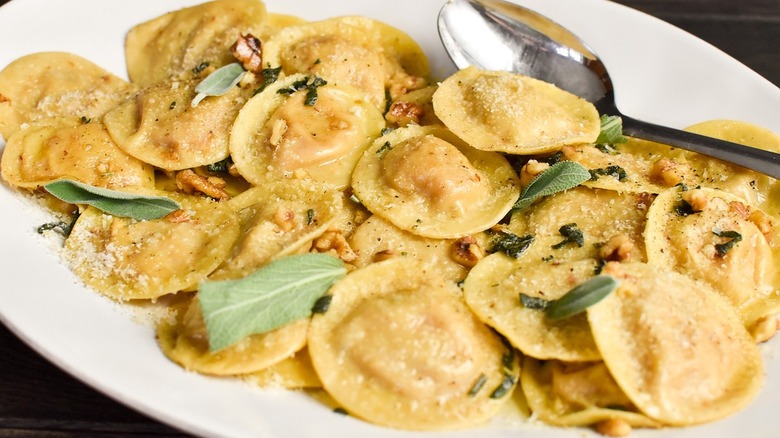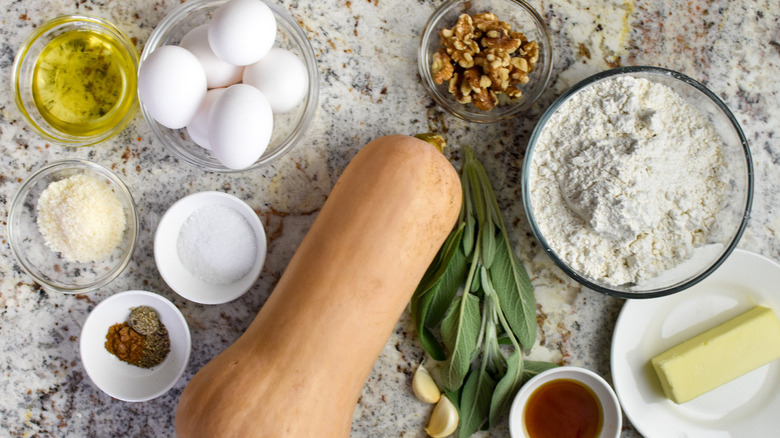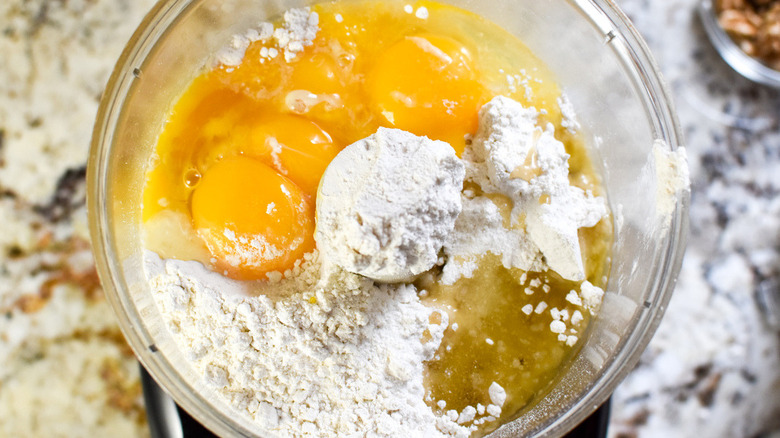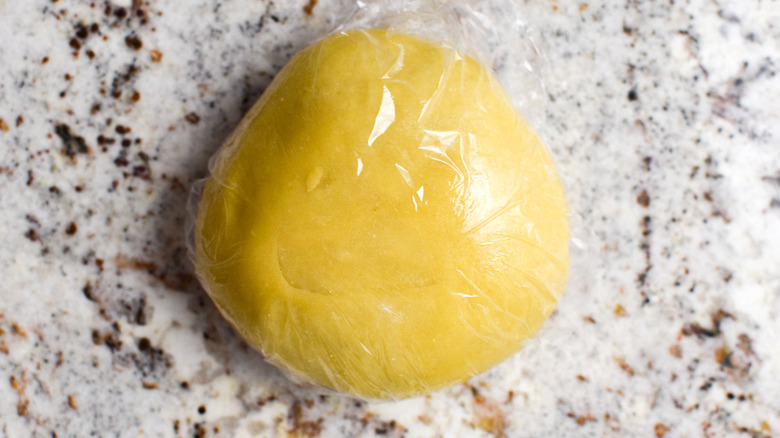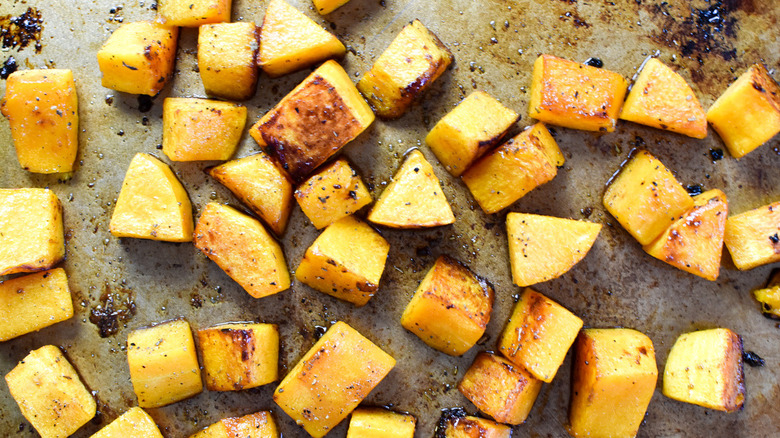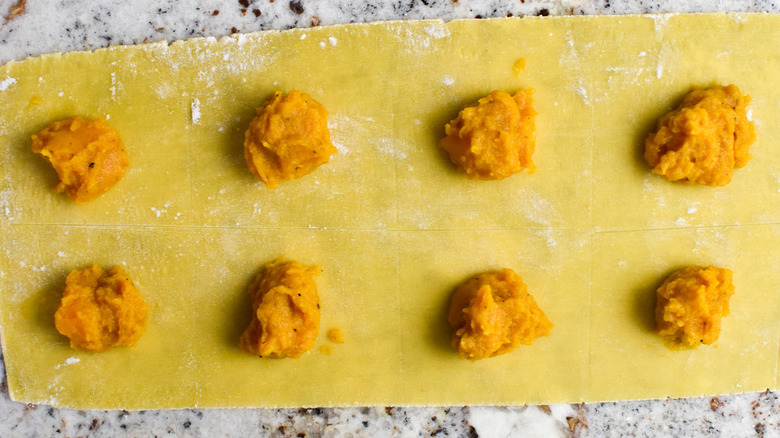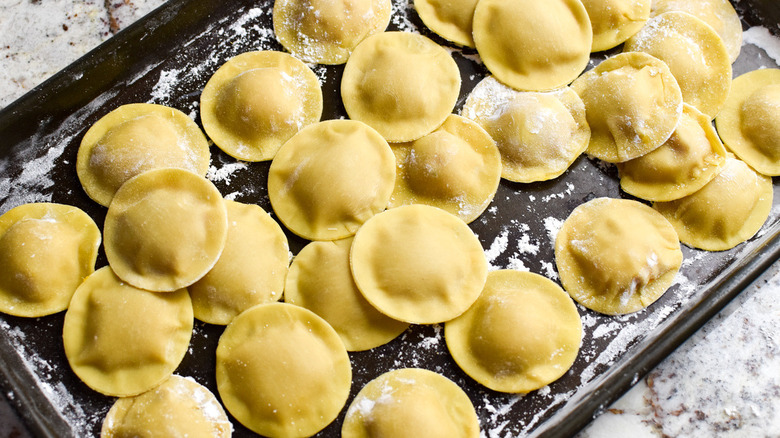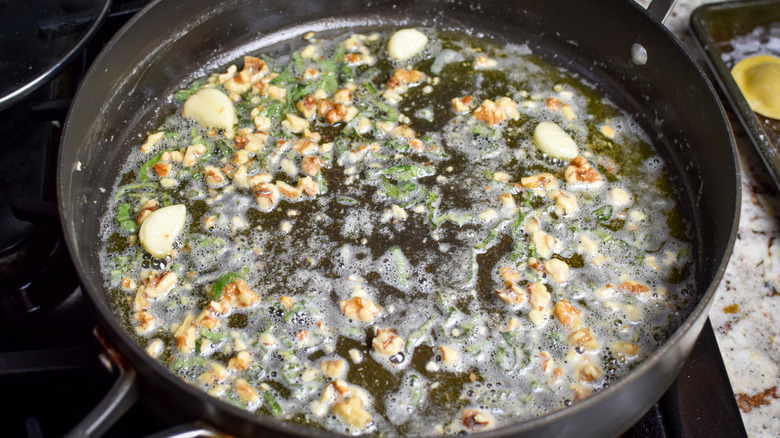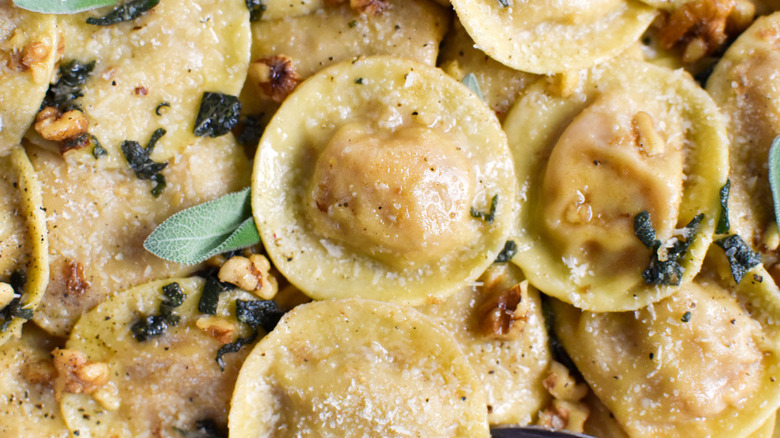Butternut Squash Ravioli Recipe
Pasta is delicious enough of on its own, but stuffed pasta takes things to a whole new level. One of the most popular types of stuffed pasta is ravioli, and while cheese ravioli may be the most common variation, there are plenty of things you could stuff into a little pasta shell. You could go the vegetarian route and make spinach ravioli, or you could take a seafood-inspired approach and make crab ravioli. Recipe developer Stephanie Rapone opted for butternut squash as her filling of choice, and the results are rich, warm, subtly sweet, and incredibly delectable.
Rapone admits that she has a sentimental tie to this butternut squash ravioli recipe, but also loves how even a beginner chef could whip this up. "It's an awesome introduction to homemade pasta if you have never made it before," she explains. "It's a simple and reliable dough, the filling is simple, and assembly is easy." Making pasta from scratch seems like a pretty daunting task, but with Rapone's recipe, this doesn't have to be the case! Follow her steps carefully and you can whip up this impressive ravioli right in your own kitchen.
Gather the ingredients for butternut squash ravioli
There are three elements to this dish — the ravioli itself, the butternut squash filling, and the sauce — but you'll notice that many ingredients overlap. For the ravioli, you'll need all-purpose flour, eggs, olive oil, and salt. For the filling, you'll need a butternut squash, butter, olive oil, maple syrup, dried sage, garam masala, pepper, salt, and Parmesan. For the sauce, you'll need butter, fresh sage, garlic cloves, and chopped walnuts.
Are you wondering what sort of flavor combination all of these ingredients will create? "The squash [has] the earthy sweetness you would expect, but the garam masala adds an element of warmth without making it taste dessert-like," Rapone describes. "The sage-butter sauce really complements the squash without competing with the flavor."
Start by making the ravioli dough
Making homemade pasta dough takes a little bit of time and effort, but the end results are absolutely worth it. So, to get started, separate 4 egg yolks from the whites. Set aside the yolks, and either dispose of or freeze the whites for a later use.
Now, into a food processor, add the flour, 2 whole eggs and the 4 separated yolks, 2 tablespoons olive oil, and ¼ teaspoon salt. Blitz these ingredients for 45-60 seconds, just until a barely-sticky dough has formed. If the dough still feels too sticky, add 1 tablespoon more of flour at a time. If the dough isn't quite coming together, go ahead and add 1 teaspoon of water at a time — add just enough for the dough to start to form a ball.
Let the dough rest and begin making the ravioli filling
Sprinkle some flour over a clean work surface, then turn the dough out of the food processor and onto the surface. Use your hands to knead the dough for about 2 minutes, then form it into a ball and wrap it up in plastic wrap. Set the dough ball aside, at room temperature, to rest for at least 1-4 hours.
As the dough takes a much-needed rest, turn your attention to the other star of the show: the butternut squash filling! First, preheat your oven to 425 F. Next, in a small bowl, melt 2 tablespoons butter in the microwave. Then, using a fork, whisk in the maple syrup and remaining 2 tablespoons olive oil.
Roast the squash
And finally, we're onto the butternut squash. Peel the entire squash, then slice it in half lengthwise. Scoop out all of the seeds, then cut each half into 1-inch chunks. Grab a rimmed baking sheet and spread the chunks out in an even layer, then grab the butter, syrup, and oil mixture and drizzle it on top. Use your hands to toss and coat each of the squash chunks, then sprinkle the dried sage, garam masala, black pepper, and ¾ teaspoon of kosher salt on top. Toss the chunks one more time, then pop the dish into the oven to bake for 40-60 minutes. Be sure to turn the squash every 20 minutes with a spatula — we want tender and caramelized squash, not burnt squash!
Once the squash is done roasting, add all of the chunks to the food processor, along with 2 tablespoons of grated Parmesan. Blitz these ingredients together until a smooth mixture forms. Just like that, you have your ravioli filling!
Roll out the pasta dough
After the dough's resting period is over, roll it out into a log, cut it in half, then cut each half into three equal pieces. Begin working with one of the six pieces, and place plastic wrap over the other five in the meantime, so they don't dry out.
Dust your workspace with flour, then begin rolling out the dough, using either a rolling pin or pasta roller. You want to form a rectangle shape that is roughly 6 inches in width, 18 inches in length, and ¹⁄₁₆-inch thick. Flip the dough over as you're rolling it so that it's even on both sides.
Repeat this process for each of the 6 dough pieces, then use a ruler and the handle of a measuring spoon to mark 3-inch segments on each rectangle — this marks the size of each piece of ravioli. Dollop a heaping tablespoon of the butternut squash filling right into the center of each ravioli square.
Cut out each ravioli
With the filling centered on one sheet of dough, carefully lay another sheet of dough on top, and use your fingers to press the very ends together, pushing out air as you do so. Now, it's time to cut the pasta. Rapone uses a cookie cutter to get perfectly even circles of ravioli, but you can use whatever tool you like best — a ravioli cutter, pizza cutter, or just a knife will get the job done. Transfer the raviolis to a flour-dusted baking sheet and repeat the process with the remaining sheets of dough and filling.
If you're worried about getting the pasta just right, start by testing out a single ravioli. "If you aren't sure if your pasta is the right thickness, make one single ravioli and cook it and try it," Rapone explains. If you take a bite and it's too thick, roll the dough out thinner, and if it tears easily, then it needs to be thicker. "Getting the thickness of the pasta right is key," she advises.
Boil the ravioli and make the sauce
It's time to make the sauce, so start by thinly slicing the fresh sage and crushing the garlic and removing the peels. Melt 4 tablespoons butter in a large skillet over medium heat, then add in the fresh sage, garlic, and chopped walnuts. Allow these ingredients to cook, stirring occasionally, then cut the heat once the butter begins to brown.
Now, get a pot of water boiling — once it reaches that boil, add in a tablespoon of salt, then add in 8-10 ravioli. Allow them to cook until they start to float, then use a slotted spoon to remove them, placing them right into the skillet with the butter sauce. Work in batches until all of the ravioli are cooked.
Toss the ravioli in sauce, garnish, and enjoy
With all of the ravioli in the skillet with the sauce, give everything a toss. Now, you're ready to serve and enjoy the fruits of your hard work! Serve the ravioli with extra Parmesan, black pepper, and fresh sage. "Wrapping chicken tenderloins with a piece of prosciutto and then baking them is a really easy and simple complement," Rapone says, if you want to take things a step further. Of course, this butternut squash ravioli is a fulfilling meal on its own, and you'll relish in the delicacy of homemade pasta.
As for leftovers, Rapone notes that you can store them in the fridge for up to five days, and simply reheat them in the microwave.
Butternut Squash Pasta Recipe
If you're ready to start making homemade pasta, this delicious recipe for butternut squash ravioli is an excellent (and forgiving!) way to start.
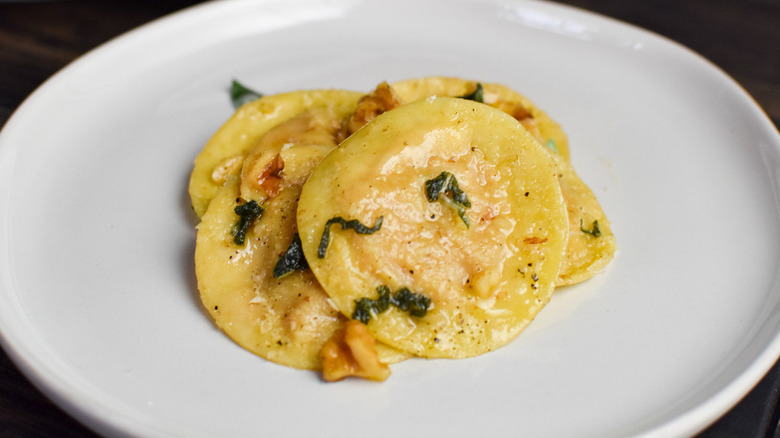
Ingredients
- 2 cups all-purpose flour, plus more for dusting
- 6 large eggs
- 4 tablespoons olive oil, divided
- 1 tablespoon + 1 teaspoon kosher salt, divided
- 6 tablespoons butter, divided
- 1 tablespoon maple syrup
- ¼ teaspoon dried sage
- ¼ teaspoon garam masala
- ¼ teaspoon fresh ground black pepper, plus more for garnish
- 2 tablespoons Parmesan cheese, plus more for garnish
- 1 ¾ pound butternut squash
- 3 cloves garlic
- 10 leaves fresh sage, plus more for garnish
- ¼ cup chopped walnuts
Directions
- Separate 4 eggs, reserving the yolks and discarding the egg whites (or freeze for another use).
- To a food processor, add the flour, 2 whole eggs, 4 egg yolks, 2 tablespoons olive oil, and ¼ teaspoon salt. Process until the mixture forms a smooth dough that is barely sticky, roughly 45 -60 seconds. If it's too sticky, add more flour 1 tablespoon at a time. If it isn't coming together into a ball, add 1 teaspoon water at a time until it comes together.
- Dust your work surface with flour. Take the dough out of the food processor and knead for 2 minutes. Wrap it in plastic wrap and set it aside to rest at room temperature for at least 1 hour, but up to 4 hours.
- While the pasta dough is resting, make the filling. Melt 2 tablespoons butter in the microwave. Add the maple syrup and remaining 2 tablespoons olive oil and whisk with a fork. Set aside.
- Preheat the oven to 425 F.
- Cut the squash in half lengthwise, scoop out all of the seeds, then cut each half into 1-inch chunks.
- Spread the squash chunks evenly on a rimmed baking sheet. Drizzle the butter, maple syrup, and olive oil mixture all over the squash and toss it with your hands to coat evenly. Then, evenly sprinkle the dried sage, garam masala, black pepper, and ¾ teaspoon kosher salt over the squash. Toss again and evenly distribute the squash across the pan.
- Roast the squash for 40-60 minutes, turning with a spatula every 20 minutes. You want the squash to be tender and caramelized, but not burned.
- When the squash is done roasting, place it and 2 tablespoons Parmesan cheese in the food processor. Process until the mixture is smooth.
- Once the pasta has rested, roll it into a log and cut it in half, then cut each half into 3 equal pieces. Start rolling out just 1 piece, covering the other 5 pieces with plastic wrap while you work so they don't dry out too much. Lightly dust your work surface or tool and roll out the dough, using either a rolling pin or pasta roller, until it is about 6x18-inches, and ¹⁄₁₆-inch thick. Turn the dough over and rotate it as you roll so that it is even.
- Slide the sheet of pasta to the side onto a floured counter while you roll the other pieces out. (Note: You want the pasta to be very thin, but not so thin you can read a newspaper through it, or it won't hold up when you form the ravioli.)
- Use a ruler and the handle of a measuring spoon to make guidelines for the pasta, making a 3-inch grid. Place 1 heaping teaspoon of filling in the middle of each square.
- Carefully lay another sheet of pasta dough over the top. Using your fingers, press the dough layers together, starting close to the filling and pushing out as much air as possible.
- Use a cutter of your choice to cut the pasta. You can use a cookie cutter so they're all the same size, but a ravioli cutter, pizza wheel, or knife all work great.
- Transfer the ravioli to a cookie sheet that's been dusted with flour. Repeat until your ravioli are all made.
- Now, make the sauce. Thinly slice the fresh sage. Smash the garlic and remove the peels. In a large skillet over medium heat, melt the remaining 4 tablespoons of butter. As soon as it's melted, add the fresh sage, garlic, and chopped walnuts. Stir and cook until the butter begins to brown, then turn off the heat.
- Bring a pot of water to a boil. Once the water is boiling, add 1 tablespoon of salt. Add 8 to 10 ravioli and cook until they float, then gently remove using a slotted spoon and place directly in the skillet with the butter sauce. Repeat with remaining ravioli in batches.
- Once your ravioli are all cooked, toss them in the sauce. Transfer to a plate and garnish with Parmesan cheese, black pepper, and fresh sage, as desired.
Nutrition
| Calories per Serving | 787 |
| Total Fat | 45.0 g |
| Saturated Fat | 16.7 g |
| Trans Fat | 0.7 g |
| Cholesterol | 328.0 mg |
| Total Carbohydrates | 78.4 g |
| Dietary Fiber | 7.3 g |
| Total Sugars | 8.1 g |
| Sodium | 913.4 mg |
| Protein | 21.3 g |
